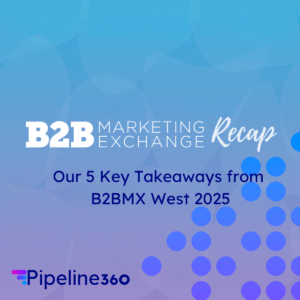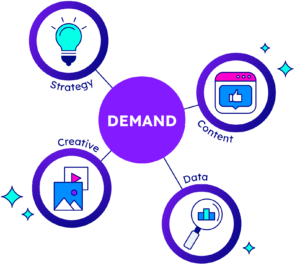Demand generation is the foundation on which all other marketing efforts are built, sowing the seeds of a broader strategy that, with proper execution, will bear fruit once leads are nurtured through the funnel to the final stop in their buyer’s journey.
Unlike isolated marketing tactics, traditional demand gen operates holistically, fuelling each stage of the buyer’s journey—from awareness and consideration to decision-making and conversion—harnessing engagement to transform potential clients into customers.
Branded demand does that too.
But better.
By blending demand generation with brand awareness, marketers can mix a powerful conversion cocktail, because like at any good party, guests who know each other already get along better.
Branded demand is making introductions sooner so that when sales call, buyers answer and engage. Familiarity is the first step to connection, generates trust, and improves the chances of conversion.
Goodbye, cold calls and ditched demos, hello, to the good old days, of marketers leading, and customers following.
The Core Differences Between Traditional Demand-Gen and Branded Demand
While demand generation and branded demand share many similarities, there are key differences in the tactics, but one doesn’t make the other obsolete.
Traditional demand is a broad-brush tactic great for short-term wins and filling the funnel. It aims to reach a large audience, and then nurture them to conversion, rather than trying to find a match, getting to know them, and keeping the diary open.
Branded demand is relationships over one-stage wins.
Casting the net wide ensures a large data haul, but also means marketers using traditional demand gen tactics have little control over their catch. Leads might not be in market yet, or worse, not even in the market for your solution. And working that out takes time and resources, and diminishes returns. Longer sales cycles – enterprise deals now take 23 weeks to move from consideration to conversion – means that headache can easily turn into a migraine.
Branded demand takes a more considered approach by combining elements of brand awareness with demand generation, to create a unified approach that elevates a brand and generates leads simultaneously. It focuses on fewer accounts and prospects, but does more for them, for longer, so a brand is always front of mind.
By highlighting a brand’s unique value proposition and integrating brand storytelling and product marketing, branded demand perfectly primes leads for conversion, taking care of the long game that traditional lead-gen ignores.
The Benefits of Traditional Demand-Gen
For speed and easy wins, lead-gen is king. It’s also well-suited to marketers operating with time or budget constraints and those needing to show immediate results – as it relies on basic metrics like clicks, downloads, or form submissions – and is easy to optimize quickly for performance.
For product launches or time-sensitive campaigns, traditional lead generation can help convey urgency, driving immediate traffic and engagement, because the focus is all about the product and what it can do – rather than the brand story.
The Benefits of Branded Demand
By focusing on brand identity alongside generating leads – marketers are making buyers get to know them from the outset. Greater brand awareness and recall help with long-term market positioning and means buyers will know your product better, for longer, so when they’re ready to buy, it will be front of mind.
Trust and loyalty go a long way in building relationships. A consistent focus on brand values helps build a deeper, more trusting connection with customers, improving retention and conversion rates. Constantly reinforcing a brand’s unique attributes also helps companies stand out, which is essential in a crowded, competitive marketplace.
Which is Right for Your Business?
Choosing which tactic is right for your business depends largely on what you want to achieve – and how quickly.
If your company is aiming for rapid growth, wants to fill up the funnel fast, is launching a new product or service and has a short sales cycle, traditional lead generation is ideal.
Building brand recognition and customer loyalty is a longer play, better suited to branded demand which is about shaping perceptions, establishing emotional connections and fostering trust over time through content, storytelling, and immersive experiences.
Putting aside your own business needs, the next thing to consider is what the audience wants. Traditional lead gen is great for potential customers already looking for solutions, whereas branded demand is better for businesses in complex, niche, or competitive markets where potential customers are going to need a lot more convincing, and patience, before they’re ready to purchase. B2B companies or those selling higher-value services often benefit from taking this approach which allows them to guide leads through a longer, more thoughtful, buyer’s journey.
Combine Both Approaches for the Best Results
Combining traditional demand generation with branded demand strategies allows marketers to benefit from both short-term lead volume and long-term brand loyalty.
Marketers can create a dual-funnel strategy by using branded demand to fill the top of the funnel by using high-quality content marketing, social media and educational resources to build awareness, trust, and emotional connections.
The middle and the bottom of the funnel can then be filled with traditional demand generation, by using lead magnets, gated content, email campaigns and outreach to convert leads into prospects. These tactics are more transactional, with a focus on driving leads to specific actions, like downloading an eBook.
Once users have engaged with branded content, marketers can retarget them with ads focused on traditional lead gen. For instance, if someone reads a branded blog, it can be followed up with display ads promoting a product or service and driving them to a lead generation form. This approach connects brand familiarity with lead capture.
Next, align content across channels. Branded demand content, like thought leadership pieces, needs to inform and support traditional demand generation campaigns, like webinars and email sequences. The transition between brand-building content and more sales-focused materials should feel seamless.
Traditional demand gen often relies on user data to segment and target leads, but when combined with branded content, personalized experiences can be created. Data from previous branded content engagements, for instance, can be used to send personalized emails more aligned to a customer’s interests, encouraging conversion, without the need for a hard sell.
Because customers now interact with brands across multiple touchpoints, combining both approaches ensures a more cohesive customer experience, with consistent messaging that moves them along seamlessly.





